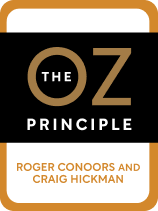

This article is an excerpt from the Shortform book guide to "The Oz Principle" by Roger Connors, Tom Smith, and Craig Hickman. Shortform has the world's best summaries and analyses of books you should be reading.
Like this article? Sign up for a free trial here .
What is The Oz Principle about? What is the underlying idea behind the authors’ Oz principle?
In their book The Oz Principle, Craig Hickman, Roger Connors, and Tom Smith lay out four steps to accountability that will move you to success both in your personal life and in your organization. The authors explain how to journey, like Dorothy from The Wizard of Oz, from a mindset of victimism to one of accountability.
Below is a brief overview of the key points.
The Oz Principle: Getting Results Through Individual and Organizational Accountability
When things feel out of your control, when you’re dissatisfied with your life or work but don’t know how to fix it, it’s easy to give up, believing there’s no point in trying if you can’t change anything.
But you have more power to create change than you think. In their book The Oz Principle, Craig Hickman, Roger Connors, and Tom Smith use the classic story of The Wizard of Oz to teach people—from individuals seeking to improve their personal lives to company leaders trying to push their teams to new heights—how to get what they want. The lesson of Dorothy’s quest is:
- No one is going to give you the things you want or need. But you have the power to achieve them yourself—as long as you don’t get stuck in a victim mindset.
In The Wizard of Oz, Dorothy and her companions travel the Yellow Brick Road in search of the Wizard. Each seeks something they believe the Wizard can provide: a way back home, courage, a heart, or a brain. To their dismay, they learn the Wizard is a fraud; there’s not a simple, magical solution to their problems. But it turns out they didn’t need the Wizard—they already had what they’d wished for.
The authors explain how to journey, like Dorothy, from a mindset of victimism to one of accountability. The Oz Principle is: To reach your goals, take initiative and assume accountability for your circumstances and your future.
(Shortform note: Viewing The Wizard of Oz as a tale about the journey from victimism to accountability isn’t the only, or even the most common, interpretation of this classic. Since its publication, both book and movie have inspired numerous allegorical interpretations. The most popular may be that Baum’s book is a political allegory for early 20th-century America.)
Authors Roger Connors and Tom Smith are founders of the consulting firm Partners in Leadership. They’ve worked with numerous businesses to improve cultures and practices around accountability. They argue that many of the most common problems that plague companies—low productivity, slow innovation, and poor morale—can be solved. But there aren’t any tricks or shortcuts. Working through those problems requires people to hold themselves accountable, first individually and then companywide.
Accountability is the bridge or behavior that moves you from victimism and failure to success. Thus, succeeding through accountability is the essence of “the Oz Principle.” (Shortform note: While many experts focus on skill, luck, and determination as the keys to success, accountability is often an underrated factor. However, accountability is arguably more important than these characteristics. In fact, the authors of The 4 Disciplines of Execution cite accountability as one of four essentials of successful execution (the others are focus, leverage, and engagement). Accountability in this formula takes the form of weekly sessions in which you review and account for your progress toward your goals.)
After introducing the problems posed by the victim mentality and explaining the difference between victim behaviors and accountability, The Oz Principle outlines four steps to becoming accountable and creating a culture of accountability in your organization: facing facts, admitting your role, taking responsibility, and taking action.
(Shortform note: Management literature often defines accountability as managers setting clear performance standards and holding employees to them—this five-step prescription is an example: Have difficult performance conversations, address poor performance as soon as possible, consider the employee’s feelings, set measurable goals, and follow up. However, The Oz Principle’s authors take a broader, transformative view of accountability encompassing personal and professional behavior by employees and leaders alike.)
Understand the Victim Mentality
Before we discuss the steps to accountability in detail, it’s important to explain what being a “victim” means in the context of “the Oz Principle” and what the consequences of victimhood are. The victim mentality encompasses a variety of behaviors and thought patterns that keep you trapped, disempowered, and unable to realize your potential. They prevent you from taking advantage of opportunities to learn and grow.
The authors explain that victim behaviors are usually passive and/or selfish. (Shortform note: The essence of both is that they’re reactive, in contrast to accountability, which is proactive.)
You may be acting from a victim mentality without being aware of it. Here are the common passive and/or selfish behaviors indicating you’re stuck:
- Deflecting responsibility (making excuses, blaming others, or waiting for someone else to act.)
- Rejecting opportunities to improve (ignoring feedback and being defensive)
- Being pessimistic and negative (complaining without offering solutions)
- Being lazy (prioritizing easy or short-term solutions over long-term ones, or glossing over problems so you look like you’re in control)
(Shortform note: These behaviors are basically opposites of the authors’ four steps to accountability: face facts, admit your role, take responsibility for solving the problem, and take action.)
The Oz Principle’s authors note that to a point, victim behaviors are understandable—in fact, they can be comforting, like a security blanket, because you’re avoiding the risks of responsibility. But they prevent you from maximizing your potential and creating a fulfilling life. By recognizing these behaviors in yourself, you can begin to let them go and focus on more productive actions. Solving problems, improving your circumstances, and getting closer to your goals will ultimately feel better than the security of victimism.
(Shortform note: Besides security, other reasons people play the victim include getting attention, gaining control or influence over others’ feelings and actions, or as a way to cope with a difficult situation.)
How Other Authors Describe a Victim Mentality
Other popular authors also address signs of having a victim mentality, but with some additional nuances not addressed by The Oz Principle.
In Daring Greatly, Brené Brown discusses the victim mentality as a contrast to what she calls the “Viking mentality.” Essentially, both “Vikings” (people who use aggression and power to present the image that they’re always in control) and “victims” (people who always feel and believe themselves to be inherently weak or powerless) are each limiting themselves in their own way. They’re not engaging with their own vulnerability in ways that allow them to grow from it. Brown acknowledges that these mindsets often arise due to trauma, but she argues that it’s a mistake when “Vikings” and “victims” blame continued hardship solely on the past trauma and not at all on the unhealthy mentality they’ve developed since.
In The Subtle Art of Not Giving a F*ck, Mark Manson discusses “perpetual victims,” those who view themselves as uniquely helpless or powerless to solve their own problems. He characterizes perpetual victims as selfish, prone to overreacting, and likely to blame other people or factors out of their control for the problems they’re facing. Like the authors of The Oz Principle, Manson emphasizes the importance of taking charge of your circumstances and focusing on the things you can control, including how you feel, how you react, and what actions you take in response.
All three of these texts portray victim mentalities as self-imposed and as a barrier to a fulfilling life. They also all acknowledge the ways that outside factors (such as trauma) can send you down a path of developing a victim mentality, but they assert the importance of recognizing these self-sabotaging thoughts and behaviors and overcoming them.
Overemphasis on the Victim Mentality Can Lead to Victim Blaming
Although most of The Oz Principle discusses victimism as a mentality to be overcome, the authors occasionally acknowledge that some people are victims due to circumstances beyond their control. The authors don’t dwell on that point beyond reasserting that how you respond to your circumstances is still up to you, which is in line with the overall accountability message of the book.
However, attributing all problems to a victim mentality can become unfair and unproductive victim-blaming, which plays a role in public discussions of many hot button topics. Victim blaming is blaming a crime or a circumstance on the victim rather than the perpetrator. This idea came up in the context of the #MeToo movement, which spotlighted the prevalence of sexual assault and harassment in various industries and in society generally. Some victims who had delayed reporting their assaults did so for fear of being blamed (or blaming themselves) for what happened to them—for instance, for drinking alcohol or dressing a certain way.
How to Be Accountable
Accountability is the solution to the problems created by the victim mentality. Accountability means owning your circumstances by identifying how your actions contributed to them and how your actions affect what happens to you next.
Being proactive and taking responsibility are elements of accountability. It’s ultimately about being in control of your life, as much as possible, rather than allowing yourself to be controlled by external forces. When you’re accountable, you’re an active player in your life, effecting change in the world around you.
With that definition of accountability, we’ll next discuss how to practice accountability. The Oz Principle lays out four steps.
Step 1: Face the Facts
You can’t have accountability if you don’t face the facts of a situation—that is, if you don’t confront reality. Reality encompasses three elements:
- Changes in your surroundings: People often try to carry on as usual when circumstances have changed. It’s irrational, but it’s something we’re all prone to doing. Don’t get stuck in that rut; face the problem and think about how to adapt. (Shortform note: The parable Who Moved My Cheese outlines five steps for facing change: Realize it’s inevitable, anticipate change, move quickly to adapt, learn to enjoy change, and prepare for continuous change.)
- Other people’s perceptions: Sometimes you’ll disagree with another person’s read of a situation, but their opinion has a real impact on you, so you need to make space for it. (Shortform note: Rather than denying the reality, you can change your behavior plus others’ perceptions of you with three steps: 1) Get more feedback (ask about the impact of your behavior and how you can do things differently); 2) Explain your intentions or the reasons behind your behavior; and 3) Ask how you’re doing on improving.)
- Your own shortcomings: Be honest with yourself about mistakes you’ve made in the past and areas where you could improve. Be open to candid feedback. (Shortform note: Thanks for the Feedback offers advice on reducing your resistance to feedback by controlling your emotional triggers, or negative knee-jerk reactions. In addition, the author suggests making it less daunting by focusing on just one aspect at a time and trying out a small change.)
The authors note that facing reality is difficult, in part, because it’s inconvenient. But confronting inconvenient truths pays off in improved relationships, career advancement, a more successful business, and a better life. The rewards are far greater, in the long run, than the false security that comes with hiding from your problems.
(Shortform note: In Principles, Ray Dalio adds that a primary benefit of embracing reality and relentlessly pursuing the truth is improving yourself—for instance, by learning from your mistakes—which he calls life’s greatest reward because it’s so fulfilling.)
Step 2: Admit Your Role
Once you’ve faced the facts of your situation, The Oz Principle’s next step toward accountability is to “own” your situation by acknowledging that you’re not only a victim of circumstance, but that you contributed to those circumstances. While this is uncomfortable, the authors point out that it comes with a benefit: Once you realize you had a hand in creating the problem, it’s easier to see how you can create the solution; it’s a way of taking back power.
The authors offer several techniques to help you see patterns of thinking and behavior that are holding you back from acknowledging your role:
- Self-Assess: Ask yourself whether you’re open to other perspectives, able to admit when you’ve messed up, and comfortable with sometimes being wrong. (Shortform note: On their website, The Oz Principle authors also offer this expanded 10-question self-assessment. Or, you can try this true-false victim mentality quiz from a counseling service.)
- Take an external point of view: Imagine giving a friend advice about the same situation. Thinking about it as an outsider can help you see your mistakes and what you could do better in the future. (Shortform note: Psychologists refer to this as self-distancing: Besides adopting an outside observer perspective, techniques include using third-person pronouns to describe the situation in writing and asking yourself how you’ll feel about the situation in a week, month, or years from now.)
- Learn from the past: When you find yourself in a difficult situation, think about a time you faced something similar before. Consider what lessons you can draw from that experience. (Shortform note: Besides reviewing a specific experience, you can make learning from experience part of your routine. In First Things First, author Stephen Covey recommends asking yourself a series of questions each week about how things went, such as: What prevented me from reaching my goals, and what are the main lessons I can take away from this week?)
- Get feedback: Ask multiple, diverse sources for honest and specific feedback; this will help you figure out if a comment is an outlier or if it’s widely shared. (Shortform note: To get the most useful feedback, ask questions like, What should I stop doing and what should I start doing?)
Step 3: Take Responsibility for Solving Problems
When you recognize a problem, you may be inclined to step aside and let someone else take care of it. But if you recognize the problem but don’t solve it, it’s likely to get worse. Being accountable requires being a problem-solver. The authors give this advice for solving problems:
- Get at the root of the issue. Don’t waste time and resources focusing on superficial aspects or symptoms, or in trying to take shortcuts.
- Mean it. Don’t just take shortcuts or try to appease anyone. Implement long-lasting solutions and honestly believe in them.
- Don’t be complacent. Always look for things you can do better. This sentiment applies not only to resolving specific problems but also to how you can approach work and life in general. Hone your existing skills and keep gaining new ones. Be aware of what other people are doing. By being a more knowledgeable and well-rounded person, you’re more likely to spot problems early and to be able to come up with solutions.
Of course, when you’re trying to solve a problem, you’ll inevitably run into roadblocks. You might get discouraged and revert to unproductive patterns of thinking. Instead, mentally brace yourself for things to get tough. Try to predict what setbacks you might encounter, and prepare for them if possible.
(Shortform note: Following is a planning strategy for businesses to anticipate and prepare for problems; the same type of thinking can work for individuals too. Regularly brainstorm with your team to identify events or conditions that could upend your business. Identify early indicators of each event or condition, and determine what actions you would need to take in response, such as workarounds. Engage your up-and-coming leaders in “scenario thinking,” or imagining a range of problem scenarios and responses. Compile the scenarios and responses in a manual.)
Step 4: Take Action
The fourth step in The Oz Principle’s journey is staying committed and following through with action.
Even when you know the solution, you may still have a hard time executing it—or you may start but give up when you encounter a problem. However, a commitment to accountability means not letting obstacles stop you, or letting momentary success or luck make you complacent.
The authors recommend the following techniques and attitudes to ensure you get the job done:
- Focus on future goals, not just the immediate situation. For example, if you’re falling behind on your sales goal for the month, it’s not enough to work around the clock for the final week to get your numbers up. Also determine how to keep it from happening again in the future.
- Keep track of the results you’re generating. The results should be concrete, whether in the form of numbers or feedback from other people, so you can measure and learn from them.
- Don’t put things off. Address problems right away. Procrastinating could weaken your commitment to following through and make the problem worse.
Accountability on an Organizational Level
The authors emphasize the importance of not only individual accountability, but also joint accountability. In any group that’s working toward a shared goal—a sports team, students submitting a group project, or employees at a company—you succeed or fail together.
To help people look beyond their basic job responsibilities and think about the things for which they share accountability with others, the authors recommend that leaders emphasize results. Make it clear to employees what specific results you’re looking for. Identify the numbers you’ll need to see to know that you’ve succeeded. To score a goal, employees have to be able to see the goalposts.
(Shortform note: In The Five Dysfunctions of a Team, Patrick Lencioni asserts that by having tangible measures of success, teams are better able to attract and retain achievement-oriented employees. Also, it’s easier to evaluate performance, and a focus on results avoids the distraction and waste of energy occurring when team members pursue individual agendas at the expense of the team.)
Once you’ve established the need to get results, defined the results you’re after, and explained how you’ll measure them, you’ll then have to motivate your team to focus on results.
(Shortform note: On their Partners in Leadership website, the authors of The Oz Principle provide an interactive tool called the Propeller, which helps leaders and their teams focus, communicate and track key results, as well as build empowerment and ownership. As one aspect of the platform, team members each create a personal impact statement of how their role and duties contribute to achieving specific results; everyone can see everyone else’s impact statement to see how roles work together. A sense of empowerment increases team members’ motivation.)
The authors cite rewards as a valuable motivational tool, even if they’re purely symbolic, like getting a gold star on your homework in school. Give people gold stars in the form of praise and recognition, as well as substantive rewards such as commissions, bonuses, and so on. Some companies offer equity, knowing that employees who own a piece of the company are invested in the whole, not just in their own job. (Shortform note: If team-based rewards aren’t structured carefully, so that they’re clear and equitable, human resources experts caution that they can undermine individual initiative, trust, and therefore team success.)
Lead From and Into an Accountability Mindset
Once you understand the building blocks of an organization-wide culture of accountability, The Oz Principle recommends these steps to become the kind of leader who can create that culture:
- Examine your own motivations. Approach the task of creating an accountability culture with a desire to help people do better. If you use “accountability” to blame other people or shame them for slipping into a victim mindset, you’ll fail to create positive change. (Shortform note: Blaming or shaming others also likely means you’re not being honest about your own role in the problem. Accountable leaders set aside pride and admit their mistakes.)
- Lead by example. Show people how you hold yourself accountable by modeling behaviors such as being proactive, owning your mistakes, focusing on results, and following through. (Shortform note: In Can’t Hurt Me, retired Navy SEAL and ultramarathoner David Goggins recommends holding yourself accountable by creating an “accountability mirror”—write your goals on notes and tape them to your mirror; then have an honest conversation about your successes and failures while looking yourself in the eye each day.)
- Be understanding. It takes time for people to learn to be accountable. If someone reverts to victimism, offer support, encouragement, and constructive feedback. (Shortform note: To best support employees, check in often and communicate more than you think is necessary.)
Take Action to Change the System
While accountability is a choice that every employee has to make, you can create conditions within your organization that ensure people make that choice:
1) Train everyone in accountability. Discuss the behaviors of accountable people versus victims. Share personal anecdotes of times you fell into a victim mindset and how you overcame it. Giving concrete examples will help people self-reflect and apply the ideas to their own lives. (Shortform note: Inc. magazine cites the following “8 habits of highly accountable people”: Take responsibility, don’t make excuses, be on time, control your own fate, own your emotions, communicate expectations, collaborate, and don’t expect praise—take satisfaction in accomplishment.)
2) Coach employees through the process of forming good habits around accountability. Coaching people is different from controlling them. Instead of telling someone what to do, ask them what they think they should do. Give them the opportunity to make decisions and solve problems, because that will help them form good habits around accountability. It also requires them to take responsibility for their own work, rather than only taking orders (thus leaving the responsibility with whoever’s directing them).
(Shortform note: To further clarify the difference between coaching and controlling (or managing), a Forbes article describes coaching as involving exploring, facilitating, partnering, encouraging ongoing improvement, and opening the door to multiple potential outcomes. In contrast, managing involves ordering, directing, meeting immediate needs, and producing a specific outcome. This chart shows additional differences in coaching mindset and behavior.)
3) Help your team maintain a positive and productive attitude by asking questions that guide them toward an accountability mindset. The key question the authors of The Oz Principle recommend asking is, “What else can I do?” This focuses people’s thinking on making progress and on how they can influence the situation.
4) Reinforce accountability behaviors so that they become habits. (Shortform note: Similarly, The Coaching Habit recommends taking advantage of daily coaching opportunities. For example, if an employee sends you a long email about a problem, respond by asking, “Before I send you a detailed reply, can you tell me what the central challenge is for you?”)
5) Finally, keep track of everyone’s progress. An accountability mindset, or lack thereof, will be evident in their work. If they falter, offer constructive feedback. If they’re succeeding, offer recognition and praise. In general, if you’re a leader, try to be present and visible.
(Shortform note: In Carrots and Sticks Don’t Work, Paul Marciano notes that managers tend to overestimate how much recognition they give. But recognition is a key part of a leader’s job, because quick recognition of positive behavior locks in that behavior while failure to reinforce it makes it less likely to be repeated. Further, a minute spent complimenting someone’s work can lead to hours of increased productivity.)

———End of Preview———
Like what you just read? Read the rest of the world's best book summary and analysis of Roger Connors, Tom Smith, and Craig Hickman's "The Oz Principle" at Shortform .
Here's what you'll find in our full The Oz Principle summary :
- Why you have more power to create change than you may realize
- How to stop thinking like a victim
- The four steps to mastering accountability






